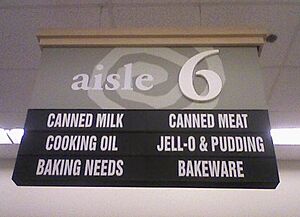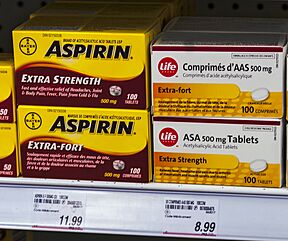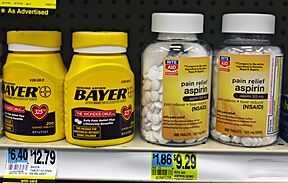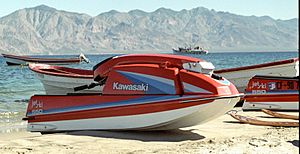Generic trademark facts for kids
A generic trademark is a special kind of brand name. Imagine a product that becomes so popular that its brand name starts being used for all similar products. This happens even if they are made by different companies. For example, many people say "Jell-O" when they mean any gelatin dessert. Or they might say "Band-Aid" for any adhesive bandage. When this occurs, the brand name becomes a "generic trademark."
This can be a problem for the company that owns the original brand. They want their name to stand out and show their product is unique. If their brand name becomes a common word for everything, they might lose its special connection. This process is sometimes called "genericide." It means the brand name loses its unique identity.
Contents
What is a Generic Trademark?
A trademark is a word, symbol, or design. It identifies and distinguishes the goods of one company from others. It's like a special signature for a company's product. When a trademark becomes a generic term, people use that brand name. They use it to talk about a whole group of products or services. This is different from just the original one.
Think about "thermos." Originally, "Thermos" was a brand name. It was for a special vacuum flask that keeps drinks hot or cold. But over time, many people started calling any vacuum flask a "thermos." This happened no matter who made it. This shows how a brand name can become a common word.
Why Brand Names Become Generic
Brand names often become generic when they are very popular. This also happens when they are among the first of their kind. For example, "aspirin" was once a brand name. It was for a pain relief medicine. But it became so widely used that it turned into the general name for that type of medicine.
Sometimes, companies accidentally help their brand names become generic. This can happen if they don't offer a simple, common name for their product. Or, they might use their own brand name in a way that sounds like a general term. For instance, the company that owned "escalator" lost its trademark. They used "escalator" in ads almost like the general word "elevator."
How Companies Protect Their Brands
Companies work hard to stop their brand names from becoming generic. They want to keep their name special. They want it linked only to their products. One way is by always using their brand name with a general word. For example, they might say "Kleenex tissues" instead of just "Kleenex." This reminds everyone that Kleenex is a specific brand of tissues.
Another strategy is to add "brand" after their trademark. An example is "Band-Aid brand bandages." This helps to clearly show it's a brand name. Companies also educate people on how to use their trademarks correctly. They might even take legal action if their brand name is used incorrectly too often.
Famous Examples of Generic Trademarks
Many well-known brand names have faced this challenge.
- Aspirin: This pain reliever was originally a brand name. It was owned by Bayer. However, in the early 1900s, courts decided that "aspirin" had become a common word for the medicine.
- Hoover: The Hoover company made popular vacuum cleaners. People started using the verb "to hoover." It meant "to vacuum clean." This is an example of a brand name becoming a common verb.
- Jet Ski: Kawasaki's "Jet Ski" is a famous brand of personal watercraft. The company works to ensure people refer to it as a "Kawasaki Jet Ski." Or they say "personal watercraft" instead of just "jet ski" for any similar vehicle.
- Google: The company Google has tried to prevent people from using "to google." They don't want it as a general verb for searching online. They want it to refer specifically to using the Google search engine.
- Xerox: Xerox made the first popular photocopying machines. They ran campaigns asking people to "photocopy" documents. They wanted people to say this instead of "xeroxing" them.
- Lego: The Lego Company encourages people to say "LEGO Bricks" or "LEGO Toys." They prefer this instead of just "Legos." They want to protect their brand name for their famous building blocks.
- Adobe Photoshop: Adobe Inc.'s "Photoshop" is powerful image editing software. People often use "photoshop" as a verb for any photo manipulation. This happens even if it's done with different software.
Protecting Names from Specific Places
Some names are protected because they come from a specific geographical location. These are called "protected designations of origin." Or they are "geographical indications." They are not trademarks in the same way. But they ensure a product truly comes from where it says it does.
For example, "Champagne" is a type of sparkling wine. To be called "Champagne," it must come from the Champagne region of France. Similarly, "Parma Ham" must be produced, sliced, and packaged in the Parma region of Italy. This helps consumers know they are getting an authentic product. It confirms it comes from its traditional source. Other examples include "Roquefort" cheese and "Scotch whisky."
How Strong is a Brand Name?
Brand names can have different levels of strength. A very strong brand name is unique. It doesn't describe the product itself. For example, "Apple" for computers. A weaker brand name might describe the product. An example is "Speedy Clean" for a cleaning service.
The strongest brand names are completely new words. Or they are existing words with no link to the product. The weakest ones are just common words for the product. Companies aim for strong, unique names. This helps ensure their brand stands out. It also prevents it from becoming a generic term.
See also
- Brand management
- Eponym
- Generic brand
- Google (verb)
- List of generic and genericized trademarks
- Metonymy
- Proper adjective
- Synecdoche
- Trademark dilution
- Counteraction principle





